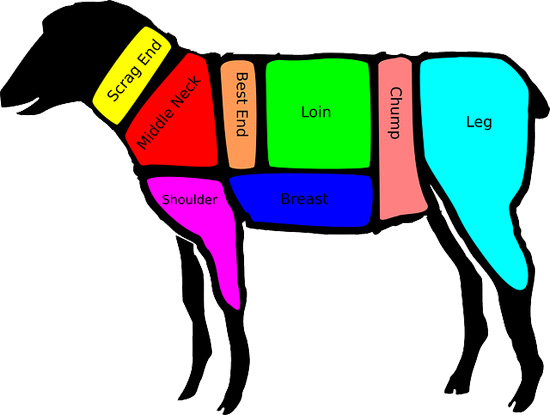
The term mutton is usually applied to the flesh of a sheep that is 1
year or more old, while lamb is the flesh of sheep under 1 year of age.
The popularity of these meats varies very much with the locality. In the
United States and Canada, a preference for lamb has become noticeable, but in
England and some other parts of Europe, mutton is more popular and is more commonly used. Both of these
meats, however, are very palatable and nutritious, so that the choice
of one or the other will always be determined by the taste or market
conditions.
Lamb that is 6 weeks to 3 months old is called spring lamb, and
usually comes into the market in January or February. The meat of sheep
1 year old is called yearling. Good mutton is cut from sheep that is
about 3 years old. Lamb may be eaten as soon as it is killed, but mutton
requires ripening for 2 or 3 weeks to be in the best condition for food.
Mutton differs from lamb very much as beef differs from veal, or as the
meat of any other mature animal differs from a young one of the same
kind. In mutton there is a smaller percentage of water and a larger
percentage of fat, protein, extractives, and flavoring substances.
There is also a difference in the appearance of lamb and mutton. Lamb is
pink and contains only small amounts of fat, while mutton is brick red
and usually has considerable firm white fat. The bones of lamb are pink,
while those of mutton are white. The outside of lamb is covered with a
thin white skin that becomes pink in mutton. The size of the pieces of
meat often aids in distinguishing between these two meats, mutton, of
course, coming in larger pieces than lamb.
Mutton and lamb are usually cut up in the same way, the dressed
animal being divided into two pieces of almost equal weight. The line of
division occurs between the first and second ribs. The back half of the animal is called
the saddle and the front half, the rack. In addition to being cut in
this way, the animal is cut down the entire length of the backbone and
is thus divided into the fore and hind quarters.
The method of cutting up the racks and saddles varies in different
localities, but, as a rule, the rack, or fore quarter, is cut up into
the neck, chuck, shoulder, rib chops, and breast; and the saddle, or
hind quarter, is divided into the loin, flank, and leg.
Browse Recipes and Related Info:
 Irish Mutton Stew Irish Mutton Stew
 Table of Mutton and Lamb Cuts Table of Mutton and Lamb Cuts
 How to Carve and Serve Mutton How to Carve and Serve Mutton
|







